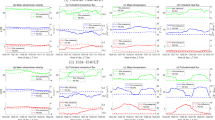Abstract
A simple two-box model of the hemispheric thermohaline circulation (THC) is considered. The model parameterizes fluctuations in the freshwater forcing by a stochastic process. The dependence of the power spectral density and the lifetime of quasistationary states of the THC on the distance to the bifurcation point, where the THC collapses, is calculated analytically. It is shown that power spectral properties change as the system is moved closer to the bifurcation point. These changes allow an estimate of the distance to the bifurcation point.
Similar content being viewed by others
Author information
Authors and Affiliations
Additional information
Received: 6 June 2002 / Accepted: 8 October 2002
Responsible Editor: Donna L. Witter
Acknowledgements. We wish to thank Till Kuhlbrodt and Sven Titz for the helpful discussions. We also thank Adam Monahan and an anonymous reviewer for their helpful comments, which greatly improved the manuscript. T.K. acknowledges support by the Volkswagen Foundation.
Rights and permissions
About this article
Cite this article
Kleinen, T., Held, H. & Petschel-Held, G. The potential role of spectral properties in detecting thresholds in the Earth system: application to the thermohaline circulation. Ocean Dynamics 53, 53–63 (2003). https://doi.org/10.1007/s10236-002-0023-6
Issue Date:
DOI: https://doi.org/10.1007/s10236-002-0023-6




